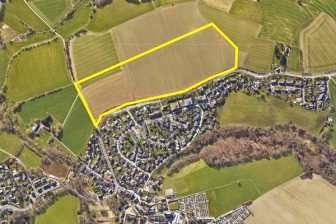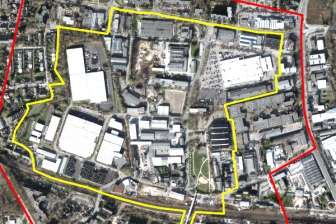Bergische Kooperation (DE)
Les Dossiers synthétiques et d'enjeux sont disponibles gratuitement.
Merci de vous inscrire et vous connecter pour accéder au Dossier complet de site.
- Dossier synthétique DE | EN
- Dossier d’enjeux EN
- Le site sur Google Maps
- Retour à la carte
Données synthétiques
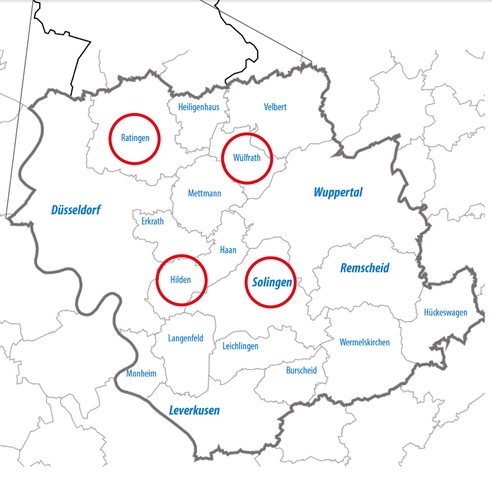
Échelle de projet XL/L/S - territoire / urbain + architecture / architecture + contexte
Localisation Hilden, Ratingen, Solingen et Wülfrath-Düssel
Population Hilden 58,000 hab. ; Ratingen 92,300 hab. ; Solingen 159,000 hab. ; Wülfrath-Düssel 21,200 hab.
Site stratégique 16,7 ha ; 91,9 ha ; 20,7 ha ; 48,42 ha
Site de projet 2,8 ha ; 43 h ; 42,5 ha ; 12 ha
Site proposé par Bergische Struktur- und Wirtschaftsförderungsgesellschaft mbH
Acteurs impliqués Hilden, Ratingen, Solingen et Wülfrath, Bergische Struktur- und Wirtschaftsförderungsgesellschaft mbH
Propriétaires du site Propriétaires publics et privés
Phase post concours Plan d'aménagement urbain
Représentant d'équipe Architecte - urbaniste - paysagiste
Information complémentaire
How can the site contribute to a productive city?
The cooperation space “between Rhein and Wupper“ wants to initiate regional and local urban quarter developments on basis of a common future concept of the project “Future Quarters between Rhein und Wupper”, that include the possibilities and challenges of the technological and social changes in a constructive way. Within this framework, four cities from this cooperation space – Hilden, Ratingen, Solingen and Wülfrath – pose a common question for the Europan 15 session. Objective and task are to design specific spatial strategies and images and, additionally, create an international momentum for the development of urban quarters in the region.
City strategy
The four sites differ in position, size and basic conditions: from the large city Solingen to the small district Düssel in the city of Wülfrath, from the transformation of a former industrial area to a new development on a green field.
All sites are located at existing or soon to be build public transport stops that should connect different scales in the region. The common objective should be answered on a strategical level for all four sites not only to gain specific solutions for the specific sites but also to generate common qualities and actions for the whole cooperation space.
Site definition
1. Hilden:
With respect to the city plan of the “Gründerzeit”, a building concept for the area between city centre and train station should be developed that combines new forms of living with commercial and freelance uses side by side.
2. Ratingen:
The city wants to initiate an extensive restructuring process with a potential new suburban train station. The given site should act as an integrational element for the train stop and a future link between the western city and the city centre. It should also act as a prototype for the cooperation and coexistence of working and living. The task is not about demolition and rebuilding but about creating a process of change in the neighbourhood. New interdependences and requirements between working and living, open spaces and mobility should be researched through this transformation.
3. Solingen-Wald:
There are several scenarios for the subsequent use of the former industrial area although the adjacent building with housing should be taken into account. The city envisions an urban quarter of living and working with a mixture of innovative undisturbing commercial uses, housing for the young and the elderly, services and other complementary uses as well as attractive open spaces with playgrounds for the kids and high quality places to stay. They expect an urban quarter with high quality urban design and architecture. The topics of “ecological resources”, “new mobility” and “equity” are also main topics of the sustainability strategy of the city. The site should become a showcase for sustainable city development in Solingen and the region.
4. Wülfrath-Düssel:
A new district should be developed that preserves the uniqueness and specific quality of the place. Given that, it is necessary to take the housing areas which serve the larger cities into account but to preserve the grown qualities of social structures and building culture and develop them. Düssel should become a lively place at which living, working and leisure can coexist. A certain challenge is to connect and interweave the new settlement area with the existing and partly historical structures of the district.
How is production inserted in the urban diversity programme?
The whole region is well known for its industrial heritage (metal, cutlery, tools, textiles, machines, automotive and chemical industry). In the present economic situation, a thematic change to digitalization and artificial intelligence is envisioned. The present economy is formed mainly by small and medium sized businesses with a high amount of manufacturing industries. The services sector is increasing in the last decade.
All four sites have specific challenges. The city of Hilden successfully transformed their economy from textile and metal industry to a services and trade town. The city of Ratingen is located very close All sites will get a new train stop in the next years. Therefor they have the chance to combine housing, working, digital production and leisure qualities with excellent traffic connections. The goal should be to create neighbourhoods or settlements that bear a lively mixture even during daytime.
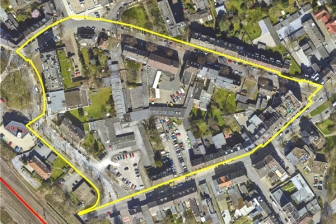 Hilden
Hilden
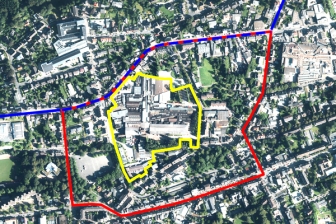 Solingen
Solingen
Questions à propos du site
Is it possible to deviate from the scale on the second poster?
Please don't. We did set the scale to keep the projects comparable. Thank you.
Le site est lié au thème suivant
IMPLANTER IMPLANTER Milieux productifs
Milieux productifs
L’enjeu pour que les villes deviennent à la fois productives et durables est de relier les ressources, les mobilités et les conditions d’équité. Il y a deux aspects à l'implantation de nouvelles dynamiques ou à la réactivation de ressources telles que l'agriculture urbaine et les forces éducatives, de recherche ou créatives : des milieux productifs et des usages productifs.
C’est le niveau auquel un environnement naturel, culturel, social ou économique est implanté ou revitalisé de façon symbiotique, par opposition à l’architecture des objets ou à l’urbanisme technocratique. Ce qui est nécessaire, donc, c’est d'activer les ressources humaines et non-humaines ainsi qu'un écosystème de partenaires, tout en étant attentif aux valeurs d’intégration entre la nature et la culture.
Questions à propos du site
Pour pouvoir poser une question, vous devez être connecté (et, par conséquent, inscrit au concours).
Ve. 16 mai 2025
Date limite de soumission des questions
Ve. 30 mai 2025
Date limite de réponses aux questions
Avant de soumettre votre question, assurez-vous qu'elle n'apparaît pas déjà dans la FAQ.
Merci de poser vos questions sur les sites dans le menu Sites.
Merci de poser vos questions sur le règlement dans le menu Règlement.
Si votre question ne reçoit pas de réponse dans les 10 jours, merci de vérifier qu'elle ne figure pas dans la FAQ sous un autre intitulé ; sinon, contactez le secrétariat concerné par email (secrétariats nationaux pour les sites, secrétariat européen pour le règlement.)
